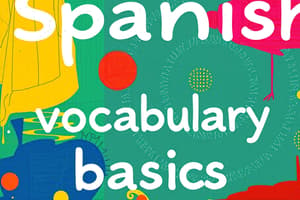Podcast
Questions and Answers
What is a key method for reinforcing vocabulary retention?
What is a key method for reinforcing vocabulary retention?
- Avoiding speaking practice
- Listening passively to conversations
- Creating flashcards for new vocabulary (correct)
- Memorizing texts without understanding
Which of the following is essential when listening to dialogues in everyday situations?
Which of the following is essential when listening to dialogues in everyday situations?
- Following short dialogues related to common scenarios (correct)
- Practicing only with written texts
- Ignoring pronunciation details
- Focusing on complex grammar structures
What is a common misconception about learning a new language?
What is a common misconception about learning a new language?
- Using cognates can ease vocabulary learning
- Practicing speaking regularly is beneficial
- Mistakes should be avoided at all costs (correct)
- It takes time and effort to learn effectively
Which aspect of listening comprehension should be focused on during practice?
Which aspect of listening comprehension should be focused on during practice?
Which strategy can assist in understanding classroom directions and announcements?
Which strategy can assist in understanding classroom directions and announcements?
Which of the following days of the week is correctly spelled in Spanish?
Which of the following days of the week is correctly spelled in Spanish?
Which question structure is correctly formed to ask someone’s name in Spanish?
Which question structure is correctly formed to ask someone’s name in Spanish?
Which of the following is a first-person singular (yo) conjugation of the verb 'comer' in the present tense?
Which of the following is a first-person singular (yo) conjugation of the verb 'comer' in the present tense?
What is the appropriate Spanish term for 'brother'?
What is the appropriate Spanish term for 'brother'?
Which article would you use to refer to 'the apple' in Spanish?
Which article would you use to refer to 'the apple' in Spanish?
Which of the following accurately describes an aspect of Spanish-speaking cultures?
Which of the following accurately describes an aspect of Spanish-speaking cultures?
Which of the following sentences correctly uses 'ser' and 'estar'?
Which of the following sentences correctly uses 'ser' and 'estar'?
Which of these colors is incorrectly translated to Spanish?
Which of these colors is incorrectly translated to Spanish?
Flashcards
Listening Comprehension Skills
Listening Comprehension Skills
The ability to understand spoken language, including conversations, instructions, and announcements.
Daily Routine Conversations
Daily Routine Conversations
Understanding and participating in basic conversations about everyday activities.
Simple Questions/Answers
Simple Questions/Answers
The ability to understand and respond to basic questions and short answers.
Vocabulary Recognition
Vocabulary Recognition
Signup and view all the flashcards
Intonation/Speaker Cues
Intonation/Speaker Cues
Signup and view all the flashcards
Spanish Greetings
Spanish Greetings
Signup and view all the flashcards
Subject-Verb Agreement (Spanish)
Subject-Verb Agreement (Spanish)
Signup and view all the flashcards
Days of the Week (Spanish)
Days of the Week (Spanish)
Signup and view all the flashcards
Simple Present Tense (Spanish)
Simple Present Tense (Spanish)
Signup and view all the flashcards
Spanish Possessive Adjectives
Spanish Possessive Adjectives
Signup and view all the flashcards
Spanish Question Words
Spanish Question Words
Signup and view all the flashcards
Regular Spanish Verbs
Regular Spanish Verbs
Signup and view all the flashcards
Spanish Articles
Spanish Articles
Signup and view all the flashcards
Study Notes
Vocabulary
- Basic greetings (e.g., ¿Qué tal?, Hola, Buenos días, Buenas tardes, Buenas noches)
- Common introductions (e.g., Me llamo..., ¿Cómo te llamas?)
- Days of the week (e.g., lunes, martes, miércoles)
- Months of the year (e.g., enero, febrero)
- Numbers 1-30
- Colors (e.g., rojo, azul, verde, amarillo)
- Family members (e.g., padre, madre, hermano, hermana)
- Parts of the body (e.g., cabeza, brazo, pierna)
- Basic classroom objects (e.g., libro, lápiz, mochila, escritorio)
- Food (e.g., pan, fruta, carne, verdura)
- Describing your characteristics (e.g., alto, bajo, rubio, moreno)
- Basic adjectives describing personality (e.g., amable, simpático, triste)
Grammar
- Subject-verb agreement in simple present tense
- Forming questions using "¿Qué...?" "¿Cómo...?" "¿Dónde...?"
- Simple affirmative and negative sentences
- Basic prepositions of place (e.g., en, sobre, debajo de)
- Using "ser" and "estar" (basic uses)
- Articles (el, la, los, las)
- Possessive adjectives (mi, tu, su, nuestro, vuestro)
- Common verb conjugation patterns for basic verbs (e.g. -ar like hablar, comer, estudiar)
Conjugation
- Conjugating regular verbs in the present tense (-ar, -er, -ir)
- Using the appropriate subject pronouns (yo, tú, él/ella/usted, nosotros/nosotras, vosotros/vosotras, ellos/ellas/ustedes)
- Recognizing the differences between regular and irregular verbs
- Understanding the relationship between verbs and their tense
- Conjugating simple verbs such as: hablar, comer, estudiar, ir, tener, estar
- Conjugation of basic irregular verbs (e.g., ser, estar, ir)
Cultural Topics
- Basic Spanish-speaking countries (e.g., Spain, Mexico, Colombia, Argentina)
- Differences in greeting customs
- Common foods and beverages in Spanish-speaking countries
- Important holidays in Spanish-speaking countries (e.g., Dia de los Muertos, Christmas, or other relevant regional holidays)
- Basic understanding of Spanish-speaking cultures and traditions
- Common family structures in Spanish-speaking cultures.
- Spanish-speaking music and art.
- Common customs and practices.
Listening Comprehension
- Understanding basic conversations about introductions, greetings, and daily routines
- Recognizing simple questions and answers
- Following short dialogues relating to common situations (e.g., ordering food, asking for directions, or describing an event)
- Understanding basic instructions or announcements (e.g., classroom directions, announcements)
- Recognizing simple vocabulary and phrases in short audio clips
- Identifying common intonation patterns and speaker cues
Important Notes
- Practice speaking regularly with a partner
- Pay attention to pronunciation and intonation
- Focus on using new vocabulary in sentences
- Learn cognates (words with similar meanings in English)
- Create flashcards for new vocabulary
- Use online resources and games to reinforce learning
- Don't be afraid to make mistakes. Learning a new language takes time and effort
Studying That Suits You
Use AI to generate personalized quizzes and flashcards to suit your learning preferences.




